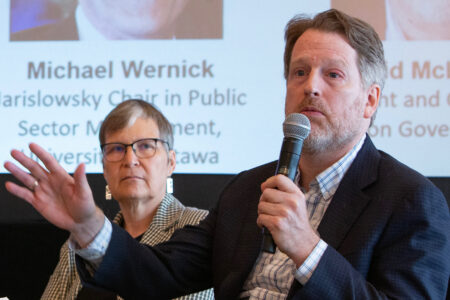
Fears about disinformation and media manipulation have sparked a call for increased citizen digital literacy in Canada. But journalists play a powerful role in amplifying what happens on social media. While citizen digital literacy certainly matters, journalists and news outlets have an important part to play in choosing what social media stories to draw attention to and in helping citizens understand how to interpret things like trending topics or viral spread of content across social media. Ahead of the federal election on October 21, journalists need to reflect on their role in the online political information system and think about when social media data are actually needed to help keep the public informed.
It is tempting to think that traditional news media organizations are losing power. Forty-eight percent of Canadian news consumers get news from social media, according to the Reuters Institute for the Study of Journalism in its Digital News Report. But television (76 percent) and online sources (including social media as well as news sites) (67 percent) still outpace social media alone. More importantly, people take cues from news sources they trust, and those sources often rely on social media in their reporting. This might include quoting a specific post, reporting on trending topics, conducting informal polls via social media or using social media to gain background information for a story. Often journalists are presenting a version of public opinion with this reporting to illustrate the public response to a given event or issue. My colleagues and I have written about this in Policy Options.
But social media is not a good representation of the general public. Take Twitter, which is most commonly used by journalists for harvesting public opinion. Only about 42 percent of online Canadians use Twitter, and we can expect those users won’t be representative of the wider public because we know younger people and those with higher levels of education and income tend to use Twitter more than others. We also know that people with limited or no access to the Internet and who lack skill in using digital tools are likely excluded when Twitter is used to indicate public opinion. We can also learn from the American context. Eighty percent of tweets are made by 10 percent of users, according to the Pew Research Center in the US. As assistant professor Shannon McGregor has shown with the 2016 US presidential election, when journalists use social media data to represent public opinion, that view of the public’s opinions is skewed.
Journalists relying on social media data in their reporting risk more than just misrepresenting public opinion. When journalists incorporate social media posts or stories into their reporting, they amplify those social media messages. And those wishing to get their political message out to the general public know news media are an important access route to wider audiences, which makes journalists a target for manipulation.
Political actors from official campaigns, advocacy groups and foreign actors might all try to use social media to promote their ideas or to diminish the perceived importance of others’ ideas. They might design campaigns to deliberately “like,” “favourite,” “share” and “retweet” content they like or to send a flood of negative comments to people or content they dislike. Associate professor Fenwick McKelvey and I wrote a report and a Policy Options piece about automated social media accounts, called political bots, which describe these amplification and dampening techniques.
It is important to recognize that those engaging in these tactics might be malicious foreign actors, like the ones Canada’s Communications Security Establishment reported are very likely, it believes, to try to influence the 2019 election. However, they could also be people and groups from within Canada who have a legitimate right to political expression during the election.
Of course, this is not new. Campaign managers, communications directors and activist leaders all know that a good news day is one where your candidate or issue is being discussed, and they actively work to make that happen. That is why journalists are trained to question and dig into the motives of the people involved in their stories. But not all journalists have been trained to question what happens on social media. Even those journalists who do question it might not have the skills or resources, because manipulation of social media data is relatively new and constantly evolving as a political tactic.
Where do journalists go from here?
Those actively reporting on disinformation, media manipulation or election interference during the campaign have no choice but to learn how these different actors are engaging in the political information system. Journalists on this beat can help the public understand what is happening on social media and, in doing so, can help build citizen digital literacy. They are faced with at least two very tricky problems.
The first is deciding which attempts at spreading disinformation, media manipulation or election interference must be known by the public. Reporting on a manipulation attempt can breathe life into it, making it much more effective than it might otherwise have been. Yet ignoring an already effective attempt could put voters in an uninformed position.
Second, journalists have to decide how much information about the technical and practical aspects of manipulation and interference campaigns they will include in their reporting. Often these campaigns are complex and highly technical, making it hard for a nonexpert to quickly understand. Journalists have limited words or just seconds in which to get their message across. But citizens need journalists to prioritize explaining the process.
There are also many journalists who cover other election topics but will still encounter these issues with social media data. The most important question these political journalists can ask themselves here is whether they really need to rely on social media data to tell a given story. If they decide they do, they will need to explain how they collected the data and why; how what they are presenting might be skewed; and what they did to ensure the data they are relying on were not manipulated.
This approach is time consuming and challenging, but it is necessary. If we do not question social media data, we open ourselves up to greater manipulation. Journalists hold a powerful position in our political information system, and they can help minimize threats and increase citizen digital literacy.
This article is part of The media and Canadian elections special feature.
Photo: Shutterstock: By suriyachan
Do you have something to say about the article you just read? Be part of the Policy Options discussion, and send in your own submission. Here is a link on how to do it. | Souhaitez-vous réagir à cet article ? Joignez-vous aux débats d’Options politiques et soumettez-nous votre texte en suivant ces directives.









